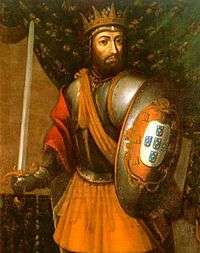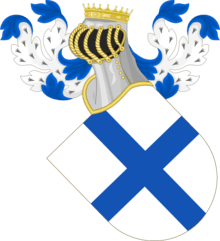Afonso III of Portugal
| Afonso III | |
|---|---|
.png) | |
| King of Portugal | |
| Reign | 4 January 1248 – 16 February 1279 |
| Predecessor | Sancho II |
| Successor | Denis |
| King of the Algarve | |
| Reign | 1249–1279 |
| Predecessor |
Sancho I as King of Silves |
| Successor | Denis |
| Count of Boulogne | |
| Reign | 1238–1253 |
| Predecessor | Matilda II |
| Successor | Matilda II |
| Regent | Matilda II |
| Born |
5 May 1210 Coimbra, Kingdom of Portugal |
| Died |
16 February 1279 (aged 68) Alcobaça, Kingdom of Portugal |
| Burial | Monastery of Alcobaça, Alcobaça, District of Leiria, Portugal |
| Spouse |
Matilda II, Countess of Boulogne Beatrice of Castile |
| Issue | See Issue |
| House | House of Burgundy |
| Father | Afonso II |
| Mother | Urraca of Castile |
| Religion | Roman Catholicism |
Afonso III (Portuguese pronunciation: [ɐˈfõsu]; rare English alternatives: Alphonzo or Alphonse), or Affonso (Archaic Portuguese), Alfonso or Alphonso (Portuguese-Galician) or Alphonsus (Latin), the Bolognian (Port. o Bolonhês), King of Portugal (5 May 1210 – 16 February 1279) was the first to use the title King of Portugal and the Algarve, from 1249. He was the second son of King Afonso II of Portugal and his wife, Urraca of Castile; he succeeded his brother, King Sancho II of Portugal, who died on 4 January 1248.
Early life
Afonso was born in Coimbra. As the second son of King Afonso II of Portugal, he was not expected to inherit the throne, which was destined to go to his elder brother Sancho.
He lived mostly in France, where he married Matilda, the heiress of Boulogne, in 1238, thereby becoming Count of Boulogne, Mortain, Aumale and Dammartin-en-Goële jure uxoris.
Reign


In 1246, conflicts between his brother, the king, and the church became unbearable. In 1247, Pope Innocent IV ordered Sancho II to be removed from the throne and to be replaced by the Count of Boulogne. Afonso, of course, did not refuse the papal order and consequently marched to Portugal. Since Sancho was not a popular king and the order was not hard to enforce, he fled in exile to Toledo, Castile, where he died on 4 January 1248. Until his brother's death and his own eventual coronation, Afonso retained and used the title of Visitador, Curador e Defensor do Reino (Overseer, Curator and Defender of the Kingdom).
In order to ascend the throne Afonso abdicated his rights to the county of Boulogne in 1248. In 1253, he divorced Matilde in order to marry Beatrice of Castile, illegitimate daughter of Alfonso X, King of Castile, and Mayor Guillén de Guzmán.
Determined not to make the same mistakes as his brother, Afonso III paid special attention to what the middle class, composed of merchants and small land owners, had to say. In 1254, in the city of Leiria, he held the first session of the Cortes, a general assembly comprising the nobility, the middle class and representatives of all municipalities. He also made laws intended to restrain the upper classes from abusing the least favored part of the population. Remembered as a notable administrator, Afonso III founded several towns, granted the title of city to many others and reorganized public administration.
Afonso showed extraordinary vision for the time. Progressive measures taken during his kingship include: representatives of the commons, besides the nobility and clergy, were involved in governance; the end of preventive arrests such that henceforward all arrests had to be first presented to a judge to determine the detention measure; and fiscal innovation, such as negotiating extraordinary taxes with the mercantile classes and direct taxation of the Church, rather than debasement of the coinage. These may have led to his excommunication by the holy see and possibly precipitated his death, and his son Denis's premature rise to the throne at only 18 years old.
Secure on the throne, Afonso III then proceeded to make war with the Muslim communities that still thrived in the south. In his reign the Algarve became part of the kingdom, following the capture of Faro.
Final years and death
Following his success against the Moors, Afonso III had to deal with a political situation concerning the country's borders with Castile. The neighbouring kingdom considered that the newly acquired lands of the Algarve should be Castilian, not Portuguese, which led to a series of wars between the two kingdoms. Finally, in 1267, the Treaty of Badajoz (1267) was signed in Badajoz, determining that the southern border between Castile and Portugal should be the River Guadiana, as it is today.
Afonso died in Alcobaça, Coimbra or Lisbon, aged 68.
Marriages and descendants
Afonso's first wife was Matilda II, Countess of Boulogne, daughter of Renaud, Count of Dammartin, and Ida, Countess of Boulogne. They had no surviving children. He divorced Matilda in 1253 and, in the same year, married Beatrice of Castile, illegitimate daughter of Alfonso X, King of Castile, and Mayor Guillén de Guzmán.
| Name | Birth | Death | Notes |
|---|---|---|---|
| By Matilda II of Boulogne (c. 1202–1262; married in 1239) | |||
| By Beatrice of Castile (1242–1303; married in 1253) | |||
| Blanche | 25 February 1259 | 17 April 1321 | Lady of Las Huelgas |
| Fernando (Ferdinand) | 1260 | 1262 | |
| Dinis (Denis) | 9 October 1261 | 7 January 1325 | Succeeded him as Denis, 6th King of Portugal. Married Infanta Isabel of Aragon. |
| Afonso | 8 February 1263 | 2 November 1312 | Lord of Portalegre. Married to Violante Manuel of Castile (daughter of Manuel of Castile). |
| Sancha | 2 February 1264 | c. 1302 | |
| Maria | 21 November 1264 | 6 June 1304 | Nun in the Convent of Saint John in Coimbra. |
| Constança (Constance) | 1266 | 1271 | |
| Vicente (Vincent) | 1268 | 1271 | |
| By Madragana (Mor Afonso) (c. 1230-?) | |||
| Martim Afonso Chichorro | c. 1250 | a. 1313 | Natural son; Married Inês Lourenço de Valadres. Ancestors of Queen Charlotte of Mecklenburg-Strelitz wife of King George III of the House of Hanover[1] |
| Urraca Afonso | c. 1260 | ? | Natural daughter; Married twice: 1st to D. Pedro Anes de Riba Vizela, 2nd to João Mendes de Briteiros |
| By Maria Peres de Enxara (?-?) | |||
| Afonso Dinis | c. 1260 | a. 1310 | Natural son; Married to D. Maria Pais Ribeira, Lady of the House of Sousa. Afonso is an ancestor of Queen Silvia of Sweden and Queen Máxima of the Netherlands |
| Other natural offspring | |||
| Leonor Afonso | c. 1250 | 1291 | Natural daughter. Married twice: 1st to D. Estevão Anes de Sousa (without issue), 2nd to D. Gonçalo Garcia de Sousa, Count of Neiva (without issue). |
| Gil Afonso | 1250 | 31 December 1346 | Natural son; Knight of the Order of the Hospital. |
| Fernando Afonso | ? | ? | Natural son; Knight of the Order of the Hospital. |
| Rodrigo Afonso | 1258 | about 12 May 1272 | Natural son; Prior of the city of Santarém. |
| Leonor Afonso (nun) | ? | 1259 | Natural daughter; Nun in the Monastery of Santa Clara of Santarém. |
| Urraca Afonso | 1250 | 4 November 1281 | Natural daughter; Nun in the Monastery of Lorvão. |
| Henrique Afonso | ? | ? | Natural son; Married to Inês (last name unknown). |
References
Ancestors
| Ancestors of Afonso III of Portugal |
|---|
|
|
External links
| Afonso III of Portugal Cadet branch of the Capetian dynasty Born: 5 May 1210 Died: 16 February 1279 | ||
| Regnal titles | ||
|---|---|---|
| Preceded by Sancho II |
King of Portugal 1248–1279 |
Succeeded by Denis |
| Preceded by Sancho I as King of Silves |
King of Algarve 1249–1279 | |
| Preceded by Matilda II as sole monarch |
Count of Boulogne, of Mortain, of Aumale and of Dammartin (jure uxoris) 1238–1253 |
Succeeded by Matilda II as sole monarch |
.png)
